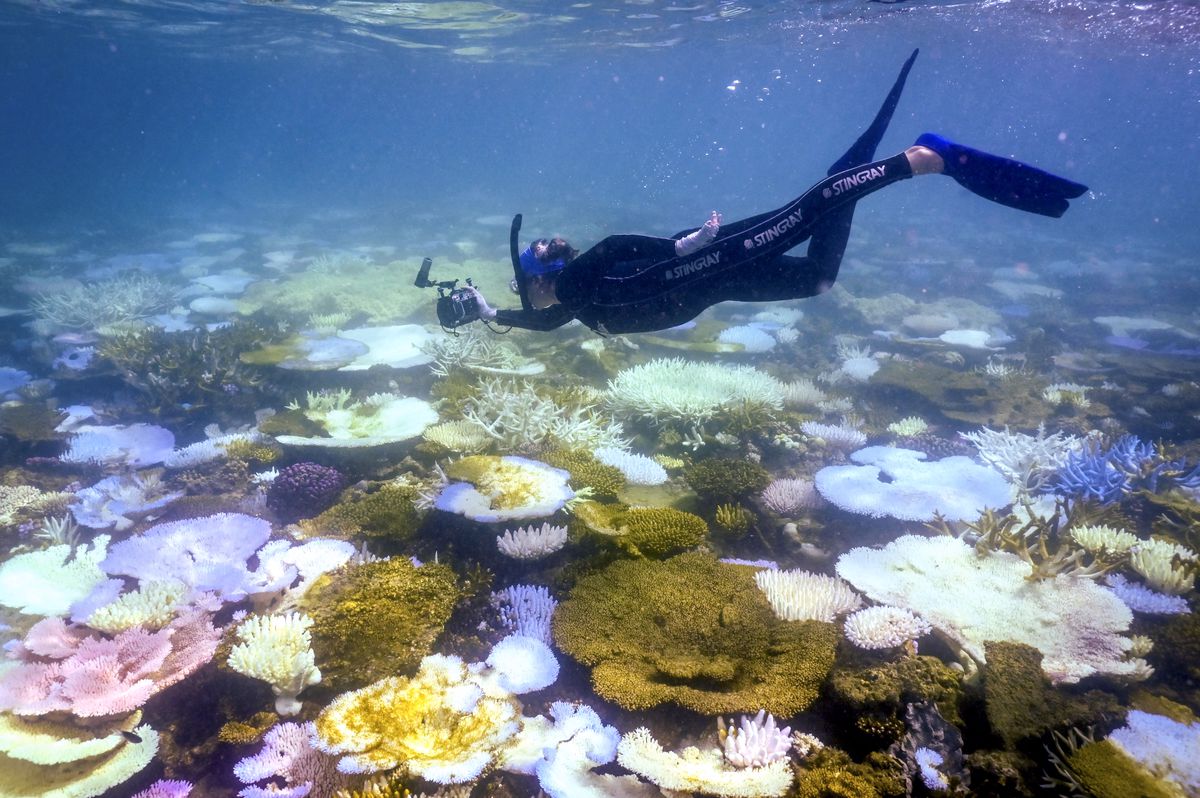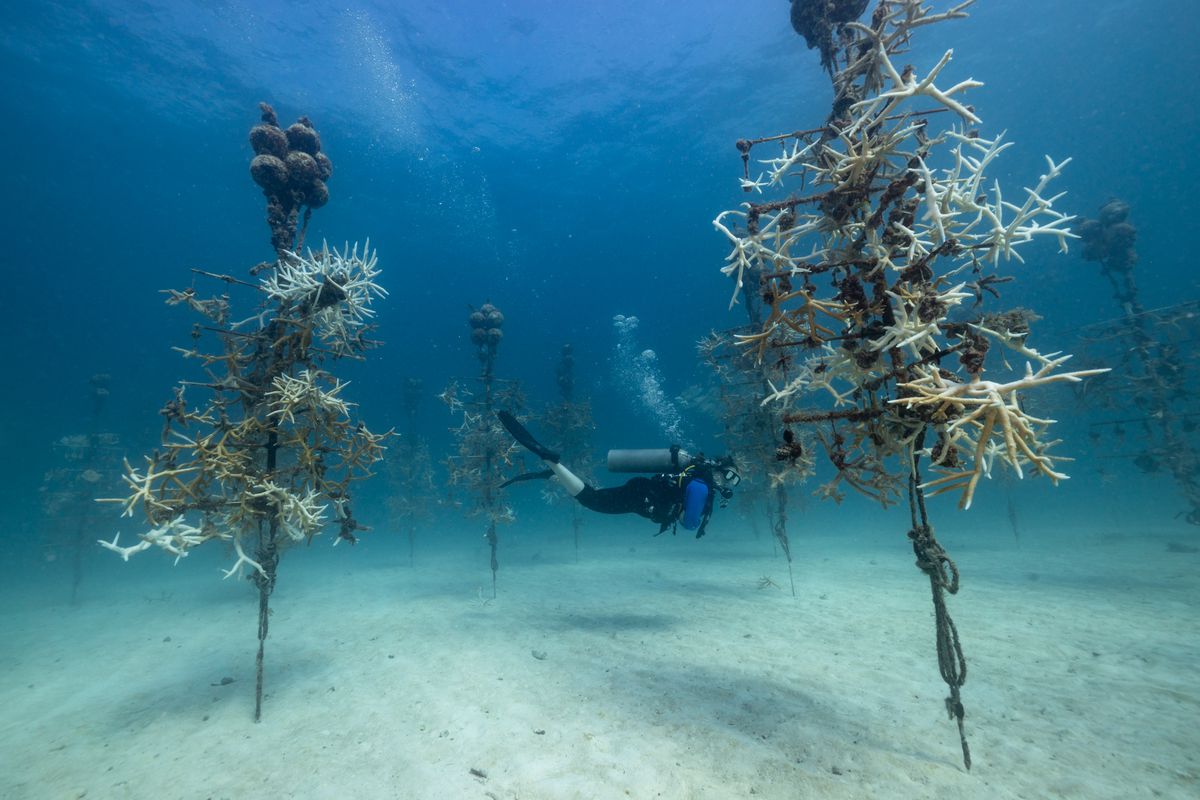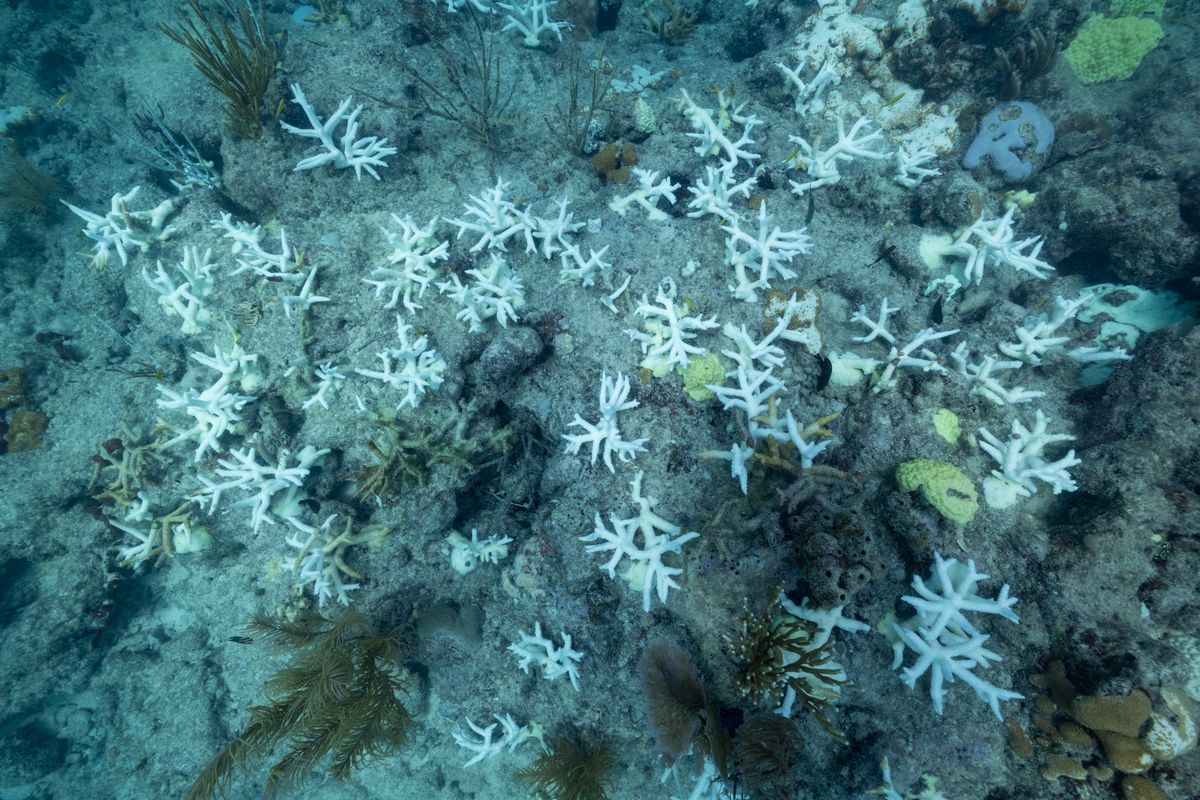April 26, 2024:
More than five years ago, the world’s top climate scientists made a frightening prediction: If the planet warms by 1.5 degrees Celsius, relative to preindustrial times, 70 to 90 percent of coral reefs globally would die off. At 2°C, that number jumps to more than 99 percent.
These researchers were essentially describing the global collapse of an entire ecosystem driven by climate change. Warm ocean water causes corals — large colonies of tiny animals — to “bleach,” meaning they lose a kind of beneficial algae that lives within their bodies. That algae gives coral its color and much of its food, so bleached corals are white and starving. Starved coral is more likely to die.
In not so great news, the planet is now approaching that 1.5°C mark. In 2023, the hottest year ever measured, the average global temperature was 1.52°C above the preindustrial average, as my colleague Umair Irfan reported. That doesn’t mean Earth has officially blown past this important threshold — typically, scientists measure these sorts of averages over decades, not years — but it’s a sign that we’re getting close.


So, it’s no surprise that coral reefs are, indeed, collapsing. Earlier this month, the National Oceanic and Atmospheric Administration (NOAA) announced that the planet is experiencing its fourth global “bleaching” event on record. Since early 2023, an enormous amount of coral in the Pacific, Atlantic, and Indian oceans has turned ghostly white, including in places like the Great Barrier Reef and the Florida Keys. In some regions, a lot of the coral has already died.
“What we are seeing now is essentially what scientists have been predicting was going to happen for more than 25 years,” Derek Manzello, a marine scientist at NOAA who leads the agency’s coral bleaching project, told Vox. The recent extreme ocean warming can’t solely be attributed to climate change, Manzello added; El Niño and even a volcanic eruption have supercharged temperatures.
But coral reefs were collapsing well before the current bleaching crisis. A study published in 2021 estimated that coral “has declined by half” since the mid-20th century. In some places, like the Florida Keys, nearly 90 percent of the live corals have been lost. Past bleaching events are one source of destruction, as are other threats linked to climate change, including ocean acidification.
The past and current state of corals raises an important but challenging question: If the planet continues to warm, is there a future for these iconic ecosystems?
What’s become increasingly clear is that climate change doesn’t just deal a temporary blow to these animals — it will bring about the end of reefs as we know them.
In the next few decades, a lot of coral will die — that’s pretty much a given. And to be clear, this reality is absolutely devastating. Regardless of whether snorkeling is your thing, reefs are essential to human well-being: Coral reefs dampen waves that hit the shore, support commercial fisheries, and drive coastal tourism around the world. They’re also home to an incredible diversity of life that inspires wonder.
“I’m pretty sure that we will not see the large surface area of current reefs surviving into the future,” said Hans-Otto Pörtner, who was involved in the landmark 2018 report, led by the Intergovernmental Panel on Climate Change (IPCC), that predicted the downfall of tropical reefs at 1.5°C warming. “Every year is going to be worse.”

But even as many corals die, reefs won’t exactly disappear. The 3D formation of a typical reef is made of hard corals that produce a skeleton-like structure. When the polyps die, they leave their skeletons behind. Animals that eat live coral, such as butterfly fish and certain marine snails, will likely vanish; plenty of other fish and crabs will stick around because they can hide among those skeletons. Algae will dominate on ailing reefs, as will “weedy” kinds of coral, like sea fans, that don’t typically build the reef’s structure.
Simply put, dead reefs aren’t so much lifeless as they are home to a new community of less sensitive (and often more common) species.
“Reefs in the future will look very different,” said Jean-Pierre Gattuso, a leading marine scientist who’s also involved with the IPCC. “Restoring coral reefs to what they were prior to mass bleaching events is impossible. That is a fact.”
On the timescale of decades, even much of the reef rubble will fade away, as there will be no (or few) live corals to build new skeletons and plenty of forces to erode the ones that remain. Remarkably, about 30 percent of the carbon dioxide that we pump into the atmosphere is absorbed by the oceans. When all that CO2 reacts with water, it makes the ocean more acidic, hastening the erosion of coral skeletons and other biological structures made of calcium carbonate.

For decades now, hard-working and passionate scientists have been trying to reverse this downward trend — in large part, by “planting” pieces of coral on damaged reefs. This practice is similar to planting saplings in a logged forest. In reef restoration, many scientists and environmental advocates see hope and a future for coral reefs.
But these efforts come with one major limitation: If the oceans continue to grow hotter, many of those planted corals will die too. Last fall, I dived a handful of reefs in the Florida Keys where thousands of pieces of elkhorn and staghorn — iconic, reef-building corals — had been planted. Nearly all of them were bleached, dead, or dying.
“When are [we] going to stop pretending that coral reefs can be restored when sea temperatures continue to rise and spike at lethal levels?” Terry Hughes, one of the world’s leading coral reef ecologists, wrote on X.
Ultimately, the only real solution is reducing carbon emissions. Period. Pretty much every marine scientist I’ve talked to agrees. “Without international cooperation to break our dependence on fossil fuels, coral bleaching events are only going to continue to increase in severity and frequency,” Manzello said. Echoing his concern, Pörtner said: “We really have no choice but to stop climate change.”

But in the meantime, other stuff can help.
Planting pieces of coral can work if those corals are more tolerant to threats like extreme heat or disease. To that end, researchers are trying to breed more heat-resistant individuals or identify those that are naturally more tolerant to stress — not only heat, but disease. Even after extreme bleaching events, many corals survive, according to Jason Spadaro, a restoration expert at Florida’s Mote Marine Laboratory. (“Massive” corals, which look a bit like boulders, had high rates of survival following recent bleaching in Florida, Spadaro said.)
Scientists also see an urgent need to curb other, non-climate related threats, like water pollution and intensive fishing. “To give corals the best possible chance, we need to reduce every other stressor impacting reefs that we can control,” Manzello told Vox.
These efforts alone will not save reefs, but they’ll buy time, experts say, helping corals hold on until emissions fall. If those interventions work — and if countries step up their climate commitments — future generations will still get to experience at least some version of these majestic, life-sustaining ecosystems.
This story appeared originally in Today, Explained, Vox’s flagship daily newsletter. Sign up here for future editions.